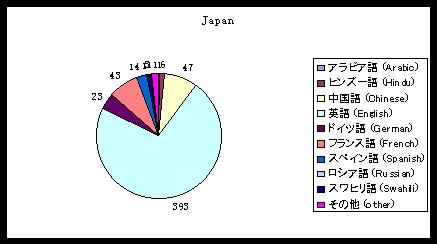‡B Identifying Perception Gaps and Comparative Analysis
3-1 The Degree of Interests in Things Overseas (Q. 19, 20, 21)
When asked whether or not students would like to study in the counterpart country, the Japanese degree of interest surpassed by 20% that of the American students. The gender difference was particularly significant where Japanese female students are eager to study in the US, and American female students indicated a low interest in studying in Japan.
[What foreign language would you like to learn most?]

In addition, an overwhelming number of Japanese students want to learn English.
The next most popular foreign languages are Chinese and French, but they attract fewer than 10% of the students' interest. Among the remaining percentage, male students tend to choose Chinese whereas women students pick French. In terms of academic aspirations, those who want to go beyond a Bachelor of Arts degree show the same amount of interest in learning Chinese as English. This possibly may be due to a major shift in the Japanese economy toward China in the future.
In the United States, Spanish, French and German are the three most popular foreign languages for the students to learn. This ranking is in accordance with other survey results gathered over the past twenty years. At NW High School, however, French and German are the more popular among the three. Since the school is situated near the Canadian boarder and has a population of predominantly Northern European ancestry with extremely few Hispanics, the geographical location could be a contributing factor for not choosing Spanish. Twenty-six percent of students at I High School chose 'other language'. Some might have been taking Japanese since the school offers Japanese as one of their foreign language options.
When asked which country the respondents would like to visit, more than half of both Japanese and American students picked Europe. Considering the results of Question 19, many Japanese students want to visit Europe for sightseeing, but chose America for studying. It should be interesting to note that Japanese students chose Asia rather than America for the place to visit.
It seems only natural that many Americans have a keen interest in Europe because three quarters of the total population have their roots in Europe. Compared to the strong orientation of Japanese toward Europe and America, we must say overall the American interest toward Asia is considerably low. It was apparently a mistake to have used the term 'Oceania' in Question 21. We meant it to be Australia and New Zealand, but hardly anyone, especially American students, knew what it referred to. If the word 'Australia' or 'New Zealand' had been used instead, the figure might have been much higher.